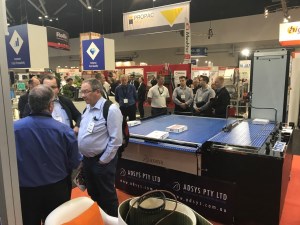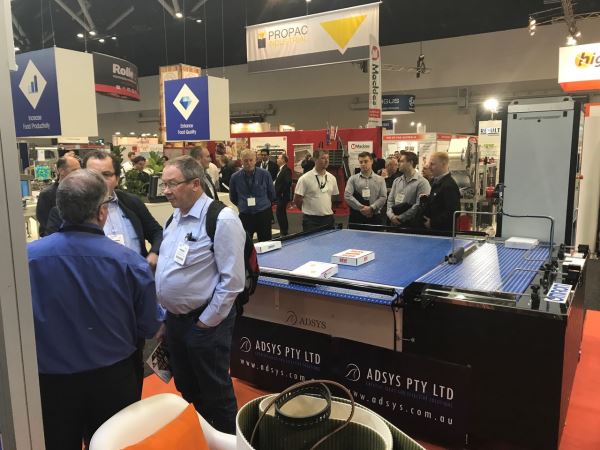More than 360 exhibitors took part in the recent foodpro 2017 exhibition in Sydney showcasing the latest in food and beverage processing, handling, packaging, ingredients and science & technology.
And one stand in particular was turning heads with its amazing display of multi-directional conveyor technology.
Rydell Beltech, the Australian arm of the global Ammeraal Beltech Group, used foodpro to launch its latest product – the uniQNB Ball belt conveyor.
This is an impressive piece of machinery to say the least.
While most conveyors transport goods in a single direction, the uni QNB’s revolutionary ball design allows goods of all shapes and sizes to be conveyed or transferred in any direction.
The uni QNB Ball belt has 1.550 balls per square metre, providing the conveyor belt with optimal flexibility of movement.
It is designed for robust environments, because the sockets for the roller balls are built directly into the links instead of being part of individual snap-in connections.
Optimal flexibility of movement
The integrated design means the belt can run stronger and longer. The tensile strength of the belt is nearly two and a half times that of competing belts.
And the closed top construction makes it harder for dirt or other contaminants to hinder the movement of the balls so the belt stays cleaner.
The balls in the uni QNB Ball belt can be directionally controlled by one or more separate auxiliary synthetic belts running under the uni QNB Ball, achieving optimal flexibility of movement. This also means that there is little to no risk of product snagging.
And with the uni QNB Ball belt you can:
- Change product speed
- Increase or decrease product spacing
- Reset spacing between products
“This product is revolutionising carton handling,” said Andrew Rivers, National Product Manager for Rydell Beltech.
“The system provides a closer contact area for products that are very light or very heavy or irregularly packed – such as a soft postpack that is only 60 percent filled with product.
“It is ideal for packaged products that are difficult to convey. We can now move them efficiently in multiple different directions using a very small footprint.
“We can move a business card that weighs just 1.5g or we can move a pallet of goods weighing 100kg.
“So, it is robust as well as being functional.”
Innovative automation system developed by Omron
The technology was developed last year by Ammeraal Beltech in the Netherlands and is set to take the world by storm.
At the heart of the Rydell Beltech uni QNB Ball belt display was an innovative automation system developed by Omron Electronics, a global leader in automation and robotics, and in conjunction with ADSYS, an Australian based company specialising in design, manufacture, installation and project management.
“The display was a collaboration between the three companies to illustrate how the system can be tailored to suit a customer’s needs,” said Mr Rivers.
Ammeraal Beltech provided the conveyor belts, Omron provided the control system and sensing solution whilst ADSYS provided the complex integration including mechanicals.
“The show has exceeded all our expectations, Mr Rivers said. “The enquiry level has been exceptional.”
Totally integrated solution
Omron sales engineer Allan Leung assisted in setting up the new system.
“Omron was able to provide a totally integrated solution,” said Mr Leung.
“We combine a total solution based on the following category of products – Input, Output, Logic and Safety (IOL+S).”
“At the heart of the control system is the Omron NX1P Micro Automation Controller using just one software suite – the Sysmac Studio, with no on-going costs of ownership,” Mr Leung said.
The system also features the Omron FQ2 series smart camera.
“The vision system is probably the most important aspect of the whole sorting station,” says Mr Leung.
“This is used to identify all the products on the conveyor. It passes on information to the control system which determines where each product is going. You can send products forwards or backwards or to the left or right.
“The vision system can also be used to read labels and barcodes or for character recognition, colours, shapes or to cover a whole host of complex algorithms.”
Unique techniques
It can also detect defects and any foreign matter.
The FQ2 contains the latest Shape Search III algorithm that uses Omron's unique techniques to search and match registered models at high speed. Shape Search III is up to nine times faster than previous technology. With the new technology high-precision and reliable position detection is possible without being affected by light interference and backgrounds.
Mr Leung said Omron, Rydell Beltech and ADSYS were pleased with the end result.
“And visitors were also very impressed, said Mr Leung. “Many said it was the most impressive stand they had seen at the Show.”


